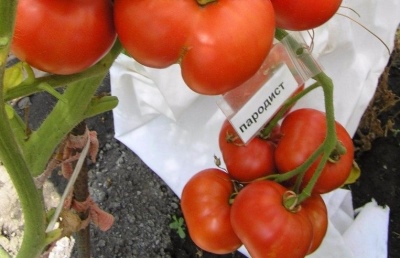
- Authors: Gavrish S.F., Morev V.V., Amcheslavskaya E.V., Degovtsova T.V., Volok O.A.
- Year of approval: 2006
- Category: grade
- Growth type: determinant
- Appointment: fresh consumption
- Ripening period: early
- Ripening time, days: 80-85
- Growing conditions: for open ground
- Marketable fruit yield,%: in the Central Black Earth region 43-61%, in the North Caucasus - 71-93%
- Bush size: undersized
The Parodist tomato can be an excellent choice for gardeners in central Russia. But that is why the most accurate information about this variety and about its cultivation is needed. It will be necessary to find out by what system the holes are placed in the garden, how to water, what fertility to count on.
Breeding history
The Parodist variety was entered into the state register in 2006. However, this plant was developed somewhat earlier. The breeders were working on the project:
- Morev;
- Gavrish;
- Amcheslavskaya;
- Degovtsova;
- Drag.
Description of the variety
The parodist shapes his bushes in a deterministic way. It must be grown mainly in open ground. Bushes grow up to 0.4-0.5 m, they are covered with dark green foliage.
The main qualities of the fruit
Having harvested, they mainly consume it fresh. The share of marketable berries in the Central Black Earth Region ranges from 43 to 61%. In the North Caucasus, this figure can reach 71-93%. Specific figures depend on weather conditions and on the perfection of agricultural technology. At an early stage, tomatoes will be green, while ripe tomatoes will turn red.
Other features:
- the weight is from 0.14 to 0.16 kg;
- the shape is flat;
- underdeveloped ribs;
- type of inflorescences simple;
- articulated peduncle;
- storage is possible only for a short period (the fruits will need to be eaten or processed as soon as possible).
Taste characteristics
The harvest is used in fresh salads. It can also be used for preservation and for any kind of food. The taste reviews are definitely positive.
Ripening and fruiting
The ripeness of berries is usually reached 80-85 days after germination. Therefore, the variety is traditionally referred to as an early group of crops. It is important to take into account that temperature, air humidity and agricultural literacy have a very important impact.
Yield
The yield indicators of the variety are quite high. In the Central Black Earth Region, they will amount to 177-352 c / ha, and in the North Caucasus - 212-362 c / ha.
The timing of planting seedlings and planting in the ground
It is necessary to sow seeds 60 days before the expected time of planting in open ground. An important role here is played by the climate of a particular area and the weather that is expected according to the long-term forecast. Experienced gardeners can also use their own farm intuition, which is often the most valuable guide. In the last week and a half, before planting in a permanent place, it is recommended to harden the seedlings.

Growing tomato seedlings is an extremely important process, because it largely depends on whether the gardener will be able to harvest at all. All aspects must be taken into account, from seedbed preparation to planting in the ground.
Landing scheme
On 1 square of the garden, you can place from 3 to 3.2 bushes. Better to stick to a lower number. By making the plant easier to care for and more responsive, you can get an excellent result this way. It is worth noting that some sources write about the 500x400 mm scheme and the ability to plant up to 6-7 bushes per 1 sq. m.But it is up to you to decide whether to trust this kind of information.

Growing and care
It is impossible to do without the formation of bushes. The Parodist's message is recommended in 3 stems. The plant tolerates the effects of cladosporiosis and fusarium wilting. However, at moments of mass infection, preventive treatment is still needed. You need to air the Parodist more actively, but watering it should be done in moderation.
Protection against fungal and viral infections is most effective at the stage of prevention. At this moment, they use the same drugs as for dealing with hazardous factors. The soil will have to be loosened more often, at least after each watering. If possible, the Parodist tomato should be grown in greenhouses or sheltered greenhouses. Seedlings are recommended to be highlighted, bringing daylight hours to 16 hours. The planted plants themselves are cared for in a standard manner, not forgetting about weeding and feeding.




A plant needs different micronutrients at each stage of growth. All fertilizers can be divided into two groups: mineral and organic. Folk remedies are often used: iodine, yeast, bird droppings, eggshells.
It is important to observe the rate and period of feeding. This also applies to folk remedies and organic fertilizers.


Growing regions
Usually it is advised to plant a Parodist in the Central Black Earth Region. It can also be cultivated in the North Caucasus. Planting in areas with less favorable climates is not very justified.

























































































